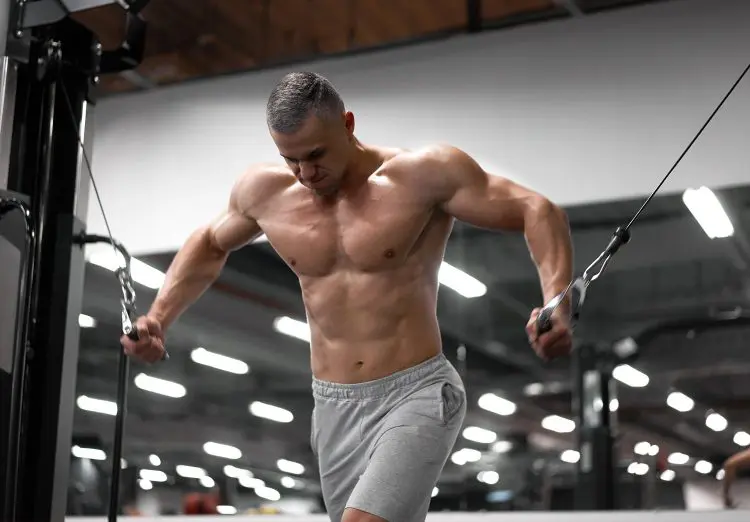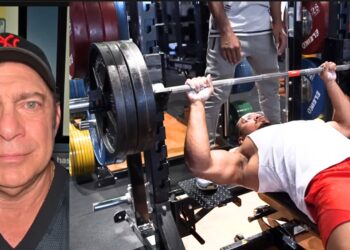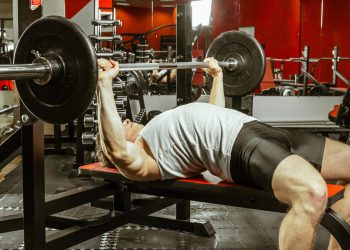Cable chest exercises should be included in every Chest Day workout—if not the star of the show, at least an important finisher.
The majority of resistance trainees use one of the two classic chest-building exercises for maximum results: Bench Press for weight lifting, and Push-Ups for bodyweight training.
Free weights are typically seen as the “champ” of weight training, and the Bench Press—with all its variations, including Decline, Incline, Close-Grip, and Wide Grip—is the go-to exercise for most bodybuilders.
People who prefer functional training, CrossFit, or bodyweight training will rely heavily on Push-Ups and its many variations: Wide Grip, Diamond, Hand-Stand, and so many more.
Both exercises have been proven to yield similar results, with one study discovering that both low-load bench press and push-ups are “comparably effective for muscle hypertrophy and strength gain”.
But the people who focus heavily on these two classic exercises often fail to miss a true hero of the training world: cable machine exercises.
Level Up Your Fitness: Join our 💪 strong community in Fitness Volt Newsletter. Get daily inspiration, expert-backed workouts, nutrition tips, the latest in strength sports, and the support you need to reach your goals. Subscribe for free!
There’s a very good argument to be made that cable chest exercises can be MORE effective for inducing hypertrophy and encouraging strength gains than either of the two go-to moves!
Why You Need to Do Cable Chest Exercises
The main reason that cable chest exercise—or any cable exercises, for that matter—are so good is due to the constant tension placed on your muscles.
When you lift free weights, there are certain points in the exercise where a) the load on your muscles is reduced, or b) your bones and joints lock out to support the weight.
An incorrectly performed Bicep Curl is a great example of the former. When you reach the top of the curl and the weight is curled, there is virtually no load on your muscles, so you get a miniature “break” between concentric and eccentric phases of the exercise.
You get the latter with a Bench Press. At the pinnacle of the push, it’s easy to lock out your elbows and let the weight rest momentarily on your skeletal structure. Again, you get a miniature “break” between the two phases of the exercise.
With cables, however, there is no “break”, only continuous time under tension. The constant tension increases the strain on your muscles, leading to faster fatigue which is potentially beneficial for stimulating muscle growth.
But that’s not the only reason to incorporate cable exercises into your workout. Some additional benefits of using the cable machine include:
- Adjustable origin point – You can raise or lower the pulley to whatever angle is most comfortable for you, allowing you to target your muscles from multiple angles. You’ll find this gives you a far more versatile workout than you could manage with free weights.
- Greater safety – With a cable machine, there’s potentially less risk of overloading your weights and injuring yourself. If the weight is too heavy, you’ll simply be unable to lift the weight stack. Your risk of injuries drastically decreases with a cable machine.
- Increased overall muscle activation – With the cable machine, it’s not just your prime mover (in this case, your chest) that does all the work, but all of the secondary stabilizer muscles that keep you balanced and steady while on your feet. Your shoulders, arms, core, and even your glutes and legs are engaged during your workout. This greater overall muscle activation burns more calories and helps you to develop better all-around functional strength.
- Functional and varied movement – With the cable machine, you can do pretty much any type of movement you want: pushing, pulling, twisting, squatting, bending, and lunging. The cable can literally be pulled or pushed in any direction, allowing you a far more varied range of movements that encourages better functionality.
A lot of pretty great reasons to mix cable chest exercises into your workout, aren’t they? You get all the benefits of free weights, but with the added bonus of constant tension, greater safety, better full-body muscle activation, and the variety that will keep your workouts from getting boring.
In our books, that makes cable exercises an absolute winner!
The 11 Best Cable Chest Exercises
If you want to incorporate cable chest exercises into your chest workout routines, here are the best, most effective muscle-building movements to use:
1. Cable Crossover
This is the superstar, a classic cable chest exercise intended to target your lower chest (pectoralis major). It’s similar to a Dumbbell Fly, but using the cable set to a high position to give you a more concentrated focus on the lower chest thanks to the downward and inward push.
You’ll get a good stretch with this exercise, with your arms spread wide during the eccentric phase and before the concentric “push” phase. This initially targets the outsides of your pecs, helping to build a broader chest. As you push your hands inward toward each other, the focus shifts to the inside of your pecs to emphasize the center of your chest.
It’s a highly effective movement that makes one heck of an excellent “finisher” to concentrate on the under-targeted inner chest.
See how it’s done:
2. Cable Bench Press
Instead of doing a regular bench press with a heavy barbell, mix it up and bring the weight bench to the cable machines. Lie flat on your back, set the handles to the lowest possible placement, and let your push muscles do the work.
The great thing about using cables for the bench press is that you get an increased workout throughout the entire exercise. You’ll have to work hard to push the weight up, but even at the peak of the movement, the cable is forcing your muscles to tense. You’ll get no “break” between the concentric and eccentric phases of the cable bench press variation.
Level Up Your Fitness: Join our 💪 strong community in Fitness Volt Newsletter. Get daily inspiration, expert-backed workouts, nutrition tips, the latest in strength sports, and the support you need to reach your goals. Subscribe for free!
But that’s not all! Because of the placement of the machine, the tendency will be for your arms to drift outward because of the tension on the cable. Your shoulder and tricep muscles have to work to keep the handles steady and controlled during the full range of up-and-down motion. This leads to faster muscle fatigue and a better workout of the secondary muscles.
See how it’s done:
3. Cable Incline Bench Press
Switch up the angle of your Bench Press to emphasize the middle and upper chest area, as well as emphasize anterior deltoid (shoulder) power.
Again, you’ll feel the cables pulling your arms slightly outward, so your secondary muscles have to work extra hard to keep your range of motion limited to purely “up and down” with as little “in and out” movement as possible. The result is greater muscle tension and a better workout for your shoulders, triceps, forearms, and even your core.
See how it’s done:
4. Cable Fly
Instead of using dumbbells for this exercise, switching to cables will maximize the time under tension for faster fatigue and potentially greater hypertrophy.
With Dumbbell Flys, you get a rest at the peak of the movement, when the weights are directly over your chest and supported by your arms and shoulders. Cable Flys, however, have no “support point”, so your chest muscles are continually under tension through the entire movement.
You’ll feel the burn faster and with far less weight, but you’ll see strength gains notably faster.
See how it’s done:
5. Low Cable Fly
This exercise uses the cable machine set at the lowest point, adapting the angle on the classic “Cable Fly” to shift the emphasis to your upper chest muscles. You’re literally pushing the handles out and up, using only your chest and shoulder muscles.
Because of the upward-slanting angle, you emphasize the upper part of your chest, helping to build better overall definition and power for this critical and often under-utilized muscle.
See how it’s done:
6. Unilateral Cable Press
“Unilateral” means “one-sided”, in this case, using just one arm at a time. Any unilateral exercise will trigger greater core recruitment because your abs, obliques, lower back, and glutes will have to activate to keep your trunk stable as you push or pull one-handed.
Adding this movement into your chest workout will give you that excellent push movement of the Cable Press, but the core engagement will help to strengthen those important core muscles that will protect you from lower back injuries down the road.
See how it’s done:
7. Cable Iron Cross
This exercise is similar to a Cable Fly, but instead of pushing inward at chest level, you push the weight inward and down toward the level of your abs. You’re still setting the handle at the highest angle possible, but the angle of your inward push will shift downward, placing the emphasis on the inner chest muscles.
This exercise is actually much easier on your shoulders and wrists than Cable Flys. If you’re recovering from an injury but still want to hit those inner chest muscles, this is the safer movement to incorporate into your workout!
See how it’s done:
8. Cable Flat Bench Fly
Remember how we talked about Dumbbell Flys and how they have a “break point” where you get a little rest at the top of the concentric phase? Using the cable machine eliminates this rest and maximizes the time under tension throughout this entire exercise.
With Cable Flat Bench Flys, you raise the handles to an angle slightly above the level of the bench, so your arms are almost fully extended throughout the full range of movement. The focus is entirely on the outer and inner chest muscles because of the constant tension of the cable machine and the elevated angle.
See how it’s done:
9. Cable One Arm Decline Fly
To maximize the focus on your lower chest muscles, lower the angle of your cable fly to a decline. Using the unilateral movement of the “One Arm Fly” forces your chest, shoulder, and arm muscles to work harder to push the weight toward the center of your chest, and your core muscles double down to keep you stable on your feet.
The result: major gains for your entire upper body anterior chain!
See how it’s done:
10. Cable Bench Press on Exercise Ball
Bring a bit of difficulty to your workout by adding in an exercise ball! A bench is solid, stable, and utterly supportive, giving you a sturdy platform to push against as you perform the Cable Press. However, with an exercise ball, there’s far more “give” on the surface, and the ball will shift and wiggle beneath you.
This makes the exercise significantly harder because your core muscles have to work double-time to keep your upper body stable as you perform the bench press.
See how it’s done:
11. Cable One Arm Press on Exercise Ball
To really make things challenging, shift to a unilateral movement that recruits just one arm at a time. Your core muscles will have to engage to keep your body stable and prevent your torso from sliding toward the arm being used to perform the press.
With the addition of an unstable platform, your chest, shoulders, and triceps will also be maximally recruited to keep the handle steady and in a controlled “up and down” motion while you perform the one-arm exercise. The result: serious muscle burn and strength gains!
See how it’s done:
Conclusion:
Cable chest exercises take your workout to the next level, thanks to the increased “time under tension” caused by the use of the cable machine. If your goal is to see serious strength gains for your chest, you’ll love how the cable exercises increase muscle recruitment and allow for more versatile emphasis of every part of your chest: upper, lower, inner, and outer.
As if that’s not reason enough, you’ll love how the cable machine more effectively recruits your secondary muscles (shoulder, triceps, and core) in every movement you do. You’ll be stronger and fitter overall thanks to the amazing cable chest exercises we’ve listed above!










Very Informative. I have tried unilateral cable press. It is very effective. Theses are really amazing result giving cable chest workouts.